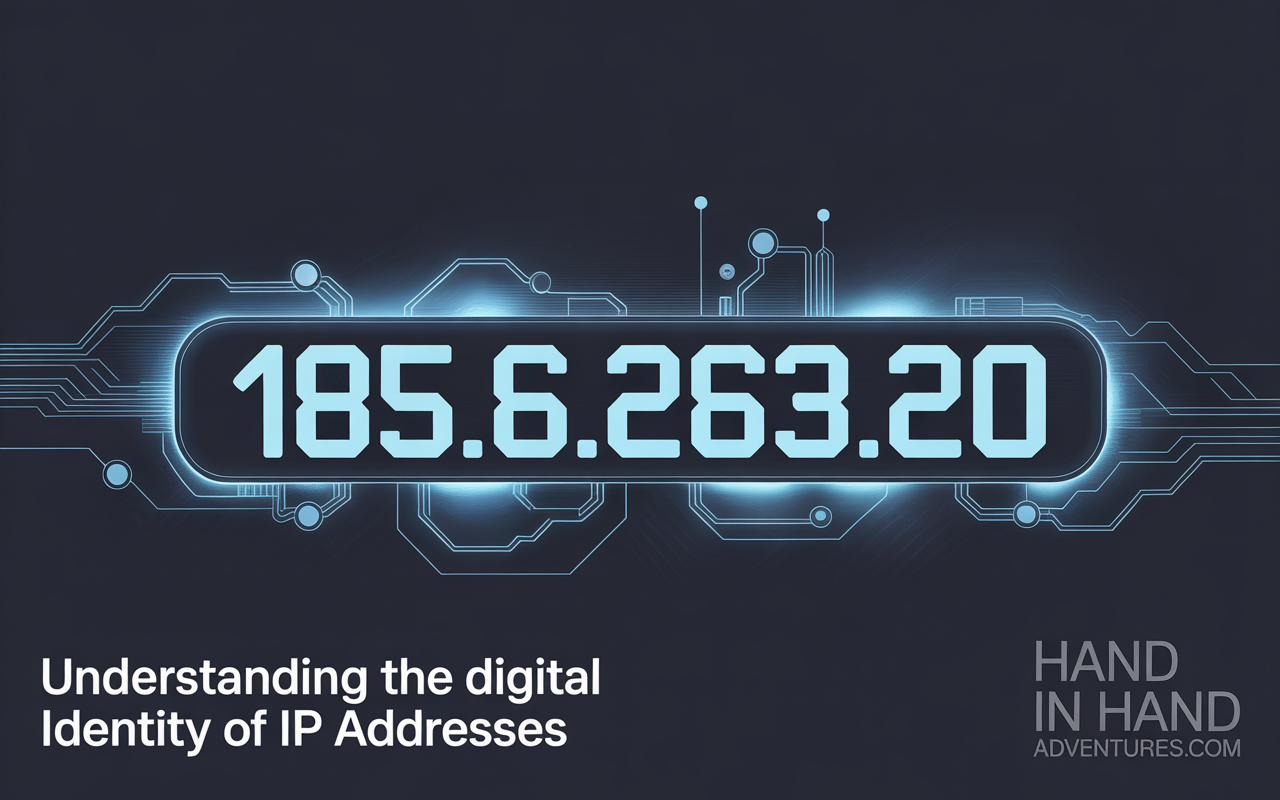Every device connected to the internet carries a unique numerical signature known as an IP address. 185.63.263.20, for instance, represents one such identifier that defines digital location and connectivity. Much like physical addresses direct mail, IP addresses direct packets of data across networks. Without them, the online world would lose structure and communication pathways. However, what appears as a simple string of numbers holds immense complexity beneath the surface. IPs serve as the backbone of the digital ecosystem, connecting servers, routers, and users across the globe. Consequently, understanding addresses like 185.63.263.20 offers insight into the invisible architecture of the modern internet.
The Technical Anatomy of 185.63.263.20
To comprehend 185.63.263.20, one must explore how IP addresses function. This numerical label falls under the IPv4 category, which uses a 32-bit format divided into four octets. Each segment ranges from 0 to 255, representing binary sequences. Thus, 185.63.263.20 identifies a specific node or device in a global network. Additionally, it links devices through protocols that enable data exchange and routing. The Internet Assigned Numbers Authority (IANA) and regional internet registries assign such addresses, ensuring unique global distribution. Therefore, every active address serves a defined role, whether for web hosting, private servers, or network management.
Tracing the Purpose Behind 185.63.263.20
While IP addresses appear random, they often belong to service providers, hosting platforms, or businesses managing servers. 185.63.263.20 could represent part of a web hosting cluster, a VPN endpoint, or even a data center hub. To determine its function, cybersecurity analysts utilize lookup tools and traceroutes. These tools reveal ownership details, geographical locations, and hosting providers associated with the address. However, data from these tools should be interpreted carefully, since many IPs are shared across multiple users or masked through proxies. Consequently, while IP addresses like 185.63.263.20 provide a starting point, they rarely expose the complete picture without deeper technical analysis.
The Role of IP Addresses in Internet Communication
Every time a user opens a website, sends an email, or streams a video, IP addresses silently facilitate the interaction. 185.63.263.20 might act as a server endpoint responding to requests or forwarding data packets. In simple terms, IPs form the map that guides information to its correct destination. Moreover, network routers read these addresses to determine the most efficient path. Without such identifiers, communication would collapse into chaos, making reliable data transmission impossible. Thus, IPs are not just numbers—they are the foundation upon which the digital experience is built.
Security Implications of 185.63.263.20
From a cybersecurity perspective, 185.63.263.20 may appear in various logs—sometimes as a benign connection, other times as a suspicious source. Because IPs can represent individuals or automated systems, their use varies widely. For instance, ethical hackers, bots, or cybercriminals might interact with the same IP at different times. Therefore, context determines whether an address poses a threat. Organizations constantly monitor incoming and outgoing IP connections to detect irregular activity. If 185.63.263.20 were found engaging in suspicious traffic, it could trigger alerts in intrusion detection systems (IDS). Hence, monitoring IP behavior forms an essential part of maintaining cybersecurity integrity.
Anonimity and IP Masking in 185.63.263.20 Context
Privacy-conscious users often hide their true IPs behind masked addresses, VPNs, or proxy networks. Consequently, 185.63.263.20 could represent an intermediary server concealing user identity. This method ensures privacy while browsing or transferring sensitive information. However, the same mechanism can also be exploited for malicious intent, such as launching cyberattacks anonymously. Balancing anonymity and accountability remains a challenge for global cybersecurity frameworks. Despite potential misuse, privacy-enhancing technologies remain vital in defending personal data from surveillance and exploitation. Thus, understanding IP masking around 185.63.263.20 underscores the double-edged nature of anonymity in the digital realm.
How IP Tracking and Geo-Location Work
When analyzing addresses like 185.63.263.20, tools often identify their approximate geographical origin. This process, called geo-location, relies on database mappings between IP ranges and registered locations. However, accuracy varies due to proxies and network rerouting. Geo-location is widely used in digital marketing, content delivery, and security threat analysis. For example, organizations may restrict access based on IP origin to prevent unauthorized access from certain regions. Although it enhances control, this technology raises ethical questions about online surveillance and data privacy. Therefore, the study of IPs extends beyond technology—it intersects with law, ethics, and global governance.
The Connection Between 185.63.263.20 and DNS Systems
Behind every IP address lies the Domain Name System (DNS), which translates human-readable domains into machine-understandable numbers. In this framework, 185.63.263.20 could represent the resolved address of a specific domain. When users type a website name, DNS servers locate its corresponding IP and establish a connection. Without this translation, browsing would require memorizing numerical addresses, making navigation cumbersome. DNS serves as the digital phonebook of the internet, ensuring that requests like “example.com” reach 185.63.263.20 seamlessly. However, attackers often exploit DNS vulnerabilities, emphasizing why DNS protection remains critical in cybersecurity.
Potential Risks Linked to Exposed IP Addresses
When an IP such as 185.63.263.20 becomes public, it might attract unwanted attention. Attackers frequently scan networks for open ports and weaknesses. Through reconnaissance, they identify exploitable systems associated with an IP. Once vulnerabilities are found, attacks like DDoS or brute-force attempts may follow. Therefore, concealing or securing exposed IPs through firewalls and proxies is essential. Additionally, employing rate-limiting, intrusion prevention systems, and encryption enhances defense. Since the internet never sleeps, constant vigilance ensures that potential threats linked to public-facing IPs are neutralized before escalation.
Ethical Use of IP Information
The responsible handling of IP data, including 185.63.263.20, remains a cornerstone of ethical cybersecurity. While IP tracking assists in fraud detection and network optimization, misuse can lead to privacy violations. Organizations must adhere to data protection laws and ethical standards, ensuring collected information is anonymized and used only for legitimate purposes. Furthermore, transparency with users builds trust and reinforces digital integrity. Ultimately, responsible IP data use defines the balance between security needs and individual rights.
185.63.263.20 and Its Role in Network Forensics
In digital forensics, IP addresses like 185.63.263.20 serve as crucial breadcrumbs leading investigators toward sources of breaches or unauthorized access. By analyzing network logs, timestamps, and connection paths, experts can reconstruct cyber incidents. However, tracing activity accurately requires cooperation between internet service providers and law enforcement. Because many IPs change dynamically or route through anonymizers, attribution remains challenging. Nonetheless, forensic methodologies evolve continuously to keep pace with new tactics used by malicious actors. Thus, IPs like 185.63.263.20 remain at the heart of digital investigation processes.
The Shift Toward IPv6 and Its Impact
As the world exhausts IPv4 addresses like 185.63.263.20, the transition toward IPv6 gains momentum. IPv6 offers a virtually unlimited pool of unique identifiers, solving the shortage caused by the internet’s explosive growth. Beyond capacity, IPv6 introduces enhanced security and routing efficiency. However, many legacy systems still rely heavily on IPv4, necessitating dual-stack configurations for compatibility. This gradual migration demonstrates how innovation must coexist with practicality in digital infrastructure. Therefore, while 185.63.263.20 belongs to the older generation, its role remains essential in today’s interconnected world.
The Importance of Reverse DNS Lookups
Reverse DNS lookups reveal which domain name corresponds to an IP like 185.63.263.20. This process proves vital for email authentication, server validation, and threat analysis. In cybersecurity, reverse lookups help determine whether traffic originates from legitimate sources or potential spam networks. Businesses use this method to protect brand integrity, while network administrators employ it for log analysis. Although simple in concept, reverse DNS verification strengthens the trust and transparency necessary for secure online interactions.
Firewall Protection and IP Filtering
Firewalls serve as the first line of defense against unauthorized access to IPs like 185.63.263.20. They inspect incoming packets, allowing or denying them based on predefined rules. IP filtering further enhances security by blocking suspicious sources or restricting access to specific regions. These strategies reduce the attack surface significantly. Moreover, when combined with deep packet inspection and intrusion prevention systems, they form a comprehensive protective barrier. Maintaining these configurations ensures that legitimate traffic flows uninterrupted while malicious attempts are thwarted effectively.
The Intersection of IP Technology and Artificial Intelligence
Artificial intelligence has transformed how IPs, including 185.63.263.20, are analyzed. Machine learning algorithms detect anomalies, predict potential attacks, and classify traffic patterns automatically. This automation enhances both speed and accuracy in cybersecurity operations. Furthermore, predictive analytics identify unusual behaviors, such as sudden spikes in data requests from specific IPs. Through continuous learning, AI adapts to emerging threats, making network management smarter and more resilient. Hence, the convergence of AI and IP analytics represents the future of digital defense.
Data Privacy Regulations and IP Transparency
As privacy regulations evolve, IP data like 185.63.263.20 falls under increased scrutiny. Laws such as the General Data Protection Regulation (GDPR) classify IPs as personal data when linked to individuals. Consequently, organizations must handle them responsibly, ensuring data minimization and consent-based collection. Transparency reports, anonymization protocols, and secure storage practices have become standard expectations. Compliance not only prevents legal penalties but also builds user confidence in digital platforms. Therefore, IP transparency and privacy remain intertwined elements of modern governance.
The Future of Cybersecurity and IP Management
The next generation of internet infrastructure will likely revolve around secure IP management systems. Platforms monitoring addresses like 185.63.263.20 already employ blockchain for immutable record-keeping. This decentralized approach increases accountability and reduces manipulation risks. Moreover, combining quantum encryption with IP frameworks promises unprecedented security levels. As technology evolves, so too will the strategies to protect network identity, ensuring stability and privacy coexist harmoniously.
Best Practices for Protecting IP Addresses
Securing IPs requires layered defense mechanisms. Regular patching, firewall maintenance, and endpoint encryption help safeguard systems associated with addresses like 185.63.263.20. Additionally, limiting administrative access and using virtual private networks (VPNs) reduce exposure. Conducting penetration testing and employing security audits uncover vulnerabilities before attackers can exploit them. By implementing these best practices consistently, both individuals and organizations can maintain the integrity of their digital infrastructure.
Conclusion:
The study of 185.63.263.20 goes beyond a numerical string—it symbolizes how every piece of the internet interconnects to create a global ecosystem. Understanding its structure, risks, and applications reveals the complexity behind everyday online interactions. As privacy concerns grow and cybersecurity challenges multiply, awareness of IP technologies becomes essential for everyone. Whether viewed through a technical, ethical, or legal lens, 185.63.263.20 underscores one truth: the internet’s strength lies in the invisible network of numbers silently holding the world together.

